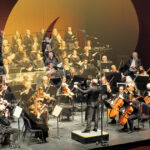Concert Review: From the Heart of Fumi / April 21, 2018
Review by D. S. Crafts
for the Journal
NMPhil Closes Seventh Season
The New Mexico Philharmonic closed out its seventh season of Classics concerts Saturday night with British music bookending two virtuoso violin showpieces from guest artist Fumiaki Miura. This also marked the end of the first season with Roberto Minczuk as Music Director, a very successful run.
The concert opened ceremoniously enough with a robust, even boisterous performance of Elgar’s Pomp and Circumstance March No. 1 (of 5), a veritable second national anthem in the UK, with the name taken from Shake-speare’s Othello.
Executive Director Marian Tanau[cq] then took the stage to announce a memorial tribute to Jennifer Riordan[cq], the young woman tragically killed in an airplane accident earlier in the week. Appropriately, the orchestra played the reverential “Nimrod” from Elgar’s Enigma Variations.
Fumiaki Miura comes to New Mexico as the youngest winner of the Joseph Joachim Hannover Violin Competition, as well as a slew of important orchestra debuts under his belt at 23 years old.
In lieu of a concerto he performed two violin bravura works, the Saint-Saens Introduction and Rondo Capriccioso, followed by Ravel’s Tzigane. Miura demonstrated an impeccable technique, easily overcoming the technical hurdles built into each piece. Clearly, he has mastered the playing of the instrument in all aspects. However, I could have asked for a more visceral, dynamic reading of both pieces, especially the Ravel. As has often been remarked, the Saint-Saens works for anyone who can tackle its difficulties. However, the Ravel is based on gypsy melodies and sentiments, and if its true character is to be realized, a player needs to put heart and fiery soul into its performance. That seemed missing here, despite the technical brilliance. (Needs more paprika!)
Holst’s The Planets (minus Earth) depicts the seven major bodies orbiting our sun — Pluto had not yet been discovered. These musical portraits illustrate astrological, not physical characteristics. When the work was composed during World War I, views of the planets were little more than fuzzy balls in even the largest telescopes. The Planets is the most popular yet least typical of Holst’s music.
Minczuk came charging forth into battle with Mars: The Bringer of War, directing an aggressive climax challenging the acoustic limits of Popejoy Auditorium. The carefully sculptured Venus: The Bringer of Peace brought out the more sensual aspects of the music, especially in the winds, harp and violin solo. A fleet-footed Mercury led to the centerpiece of the work, Jupiter: The Bringer of Jollity with its majestic, hymn-like melody, perhaps the most memorable of all Holst’s work.
Uranus: The Magician (give it the original Greek pronunciation oo-RA-nos if you want to avoid the unfortunate English name) used ever-changing orchestral color to perform its magic, sometimes humorous, sometimes dark and ominous.
The celestial journey ended with Neptune: The Mystic in its ethereal garb, augmented with a women’s chorus offstage which, as per Holst’s instructions, wistfully and gradually descended into complete silence. An orchestral tour de force to end the season.




